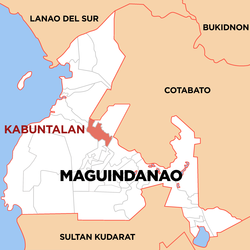Kabuntalan
Apariencia
Kabuntalan | |
|---|---|
Municipalidad | |
 Mapa de Maguindánao del Norte con Kabuntalan resaltado | |
 | |
| Coordenadas: 7°7'N, 124°23'E | |
| Nación | Filipinas |
| Región | Maguindánao del Norte |
| Provincia | Maguindánao del Norte |
| Número de barangay | 17 |
| Gobierno | |
| • Type | consejo municipal |
| • Electorado | Error en la secuencia de órdenes: la función «getValue» no existe. votantes (9 Mayo 2022) |
| Superficie | |
| • Total | 371,08 km2 (143,27 sq mi) |
| Elevation | 4 m (13 ft) |
| Populación (1 Mayo 2020) | |
| • Total | 25,439 |
| • Densidad | 0,069/km2 (0,18/sq mi) |
| • Hogares | 3,950 |
| Economía | |
| • Clase de ingresos | el ika cinco clase de municipalidad |
| • Incidencia de la pobreza | Error en la secuencia de órdenes: la función «getValue» no existe.% (Error: fecha y hora no válidas.)[2] |
| • Ingresos | ₱ <strong4a4df3e5">Error (Error: fecha y hora no válidas.) |
| • Activos | ₱ <strong4a4df3e5">Error (Error: fecha y hora no válidas.) |
| • Pasivos | ₱ <strong4a4df3e5">Error (Error: fecha y hora no válidas.) |
| • Gastos | ₱ <strong4a4df3e5">Error (Error: fecha y hora no válidas.) |
| Huso horario | UTC+8 (PST) |
| Código postal | 9606 |
| PSGC | |
| Código telefonico | 64 |
| Lenguaje nativo | idioma maguindánao Tagalog |
| Website | http://www.kabuntalan.gov.ph/ |
Kabuntalan el ika cinco clase de municipalidad na provincia de Maguindánao del Norte, Filipinas. Tiene este zona de 371.08 kilometro cuadrado.
Comporme del 1 Mayo 2020 censo este tiene papulidad de 25,439 personas y 3,950 hogares. El designada codigo postal 9606 y PSGC 153814000.
Barangay
[revisa | revisa codigo]- Bagumbayan
- Buterin
- Dadtumog (Dadtumeg)
- Gambar
- Ganta
- Katidtuan
- Langeban
- Liong
- Lower Taviran
- Maitong
- Matilak
- Pagalungan
- Payan
- Pedtad
- Pened
- Poblacion
- Upper Taviran
Demografía
[revisa | revisa codigo]| Año | Populación | ±% p.a. |
|---|---|---|
| 1918 | 4062 | — |
| 1939 | 5393 | +1.36% |
| 1960 | 13 012 | +4.28% |
| 1970 | 11 465 | −1.26% |
| 1975 | 9693 | −3.31% |
| 1980 | 11 603 | +3.66% |
| 1990 | 16 842 | +3.80% |
| 1995 | 19 409 | +2.69% |
| 2000 | 23 137 | +3.84% |
| 2007 | 22 363 | −0.47% |
| 2010 | 16 794 | −9.90% |
| 2015 | 17 276 | +0.54% |
| 2020 | 25 439 | +7.91% |
| Ref: Autoridad de Estadísticas de Filipinas[3][4][5][6] | ||
Referencias
[revisa | revisa codigo]- ↑ «Province: Maguindanao». PSGC Interactive. Quezon City, Philippines: Philippine Statistics Authority. Consultado el Diciembre 17, 2016.
- ↑ «PSA Releases the 2021 City and Municipal Level Poverty Estimates» (2 Abril 2024).
- ↑ Census of Population (2015). "ARMM – Autonomous Region in Muslim Mindanao". Total Population by Province, City, Municipality and Barangay. Philippine Statistics Authority.
- ↑ Census of Population and Housing (2010). "ARMM – Autonomous Region in Muslim Mindanao". Total Population by Province, City, Municipality and Barangay. NSO.
- ↑ Censuses of Population (1903–2007). "ARMM – Autonomous Region in Muslim Mindanao". Table 1. Population Enumerated in Various Censuses by Province/Highly Urbanized City: 1903 to 2007. NSO.
- ↑ «Province of Maguindanao». Municipality Population Data. Local Water Utilities Administration Research Division. Consultado el Diciembre 17, 2016.
Enlaces externos
[revisa | revisa codigo]- PhilAtlas.com
- Philippine Standard Geographic Code
- Local Governance Performance Management System
- www
.kabuntalan .gov .ph
| Buluan (cabecera) | |
| Municipalidad: | Ampatuan ▪ Barira ▪ Buldon ▪ Buluan ▪ Datu Abdullah Sangki ▪ Datu Anggal Midtimbang ▪ Datu Blah T. Sinsuat ▪ Datu Hoffer Ampatuan ▪ Datu Montawal ▪ Datu Odin Sinsuat ▪ Datu Paglas ▪ Datu Piang ▪ Datu Salibo ▪ Datu Saudi Ampatuan ▪ Datu Unsay ▪ General Salipada K. Pendatun ▪ Guindulungan ▪ Kabuntalan ▪ Mamasapano ▪ Mangudadatu ▪ Matanog ▪ Northern Kabuntalan ▪ Pagalungan ▪ Paglat ▪ Pandag ▪ Parang ▪ Rajah Buayan ▪ Shariff Aguak ▪ Shariff Saydona Mustapha ▪ Upi del Sur ▪ Sultan Kudarat ▪ Sultan Mastura ▪ Sultan sa Barongis ▪ Talitay ▪ Talayan ▪ Upi |
| Ciudad: | Cotabato |
